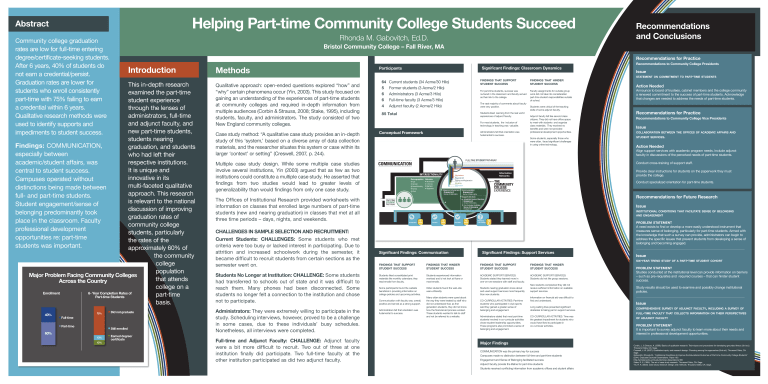
Helping Part-time Community College Students Succeed
Abstract
Rhonda M. Gabovitch, Ed.D.
Community college graduation
rates are low for full-time entering
degree/certificate-seeking students.
After 6 years, 40% of students do
not earn a credential/persist.
Graduation rates are lower for
students who enroll consistently
part-time with 75% failing to earn
a credential within 6 years.
Qualitative research methods were
used to identify supports and
impediments to student success.
Bristol Community College – Fall River, MA
Recommendations for Practice
Introduction
This in-depth research
examined the part-time
student experience
through the lenses of
administrators, full-time
and adjunct faculty, and
new part-time students,
students nearing
Findings: COMMUNICATION,
graduation, and students
especially between
who had left their
academic/student affairs, was
respective institutions.
It is unique and
central to student success.
innovative in its
Campuses operated without
multi-faceted
qualitative
distinctions being made between
approach.
This
research
full- and part-time students.
is
relevant
to
the
national
Student engagement/sense of
discussion of improving
belonging predominantly took
graduation rates of
place in the classroom. Faculty
community college
professional development
students, particularly
opportunities re: part-time
the rates of the
students was important.
approximately 60% of
the community
college
population
Major Problem Facing Community Colleges
that
attends
Across the Country
college on a
Enrollment
6- Year Completion Rates of
part-time
Part-time Students
basis.
40%
75%
Did not graduate
Full-time
Part-time
Still enrolled
60%
13%
12%
Recommendations
and Conclusions
Earned degree/
certificate
Methods
Qualitative approach: open-ended questions explored “how” and
“why” certain phenomena occur (Yin, 2003). This study focused on
gaining an understanding of the experiences of part-time students
at community colleges and required in-depth information from
multiple audiences (Corbin & Strauss, 2008; Stake, 1995), including
students, faculty, and administrators. The study consisted of two
New England community colleges.
Case study method: “A qualitative case study provides an in-depth
study of this ‘system,’ based on a diverse array of data collection
materials, and the researcher situates this system or case within its
larger ‘context’ or setting” (Creswell, 2007, p. 244).
Significant Findings: Classroom Dynamics
Participants
64
5
6
6
4
Current students (34 Acme/30 Hilo)
Former students (3 Acme/2 Hilo)
Administrators (3 Acme/3 Hilo)
Full-time faculty (3 Acme/3 Hilo)
Adjunct faculty (2 Acme/2 Hilo)
85 Total
FINDINGS THAT SUPPORT
STUDENT SUCCESS
FINDINGS THAT HINDER
STUDENT SUCCESS
For part-time students, success was
nurtured in the classroom and faculty served
as their link to the college.
Faculty assignments for outside group
work did not take into consideration
part-time student responsibilities outside
of school.
The vast majority of comments about faculty
were very positive.
Students liked learning from the real world
experiences of adjunct faculty.
For most students, the inclusion of
technology in teaching was valuable.
Conceptual Framework
Adminstrators felt that orientation was
fudamental to success.
Students were critical of the teaching
skills of some adjunct faculty.
Adjunct faculty felt like second class
citizens. They did not have office space
to meet with students and organize
class materials. They received no
benefits and were not provided
professional development opportunities.
Some students, especially those who
were older, faced significant challenges
in using online technology.
Full-time and Adjunct Faculty: CHALLENGE: Adjunct faculty
were a bit more difficult to recruit. Two out of three at one
institution finally did participate. Two full-time faculty at the
other institution participated as did two adjunct faculty.
Action Needed
Announce to board of trustees, cabinet members and the college community
a renewed commitment to the success of part-time students. Acknowledge
that changes are needed to address the needs of part-time students.
Recommendations for Practice
Recommendations to Community College Vice Presidents
Issue
COLLABORATION BETWEEN THE OFFICES OF ACADEMIC AFFAIRS AND
STUDENT SERVICES.
Action Needed
Provide clear instructions for students on the paperwork they must
provide the college.
Conduct specialized orientation for part-time students.
Recommendations for Future Research
Issue
INSTITUTIONAL CONDITIONS THAT FACILITATE SENSE OF BELONGING
AND ENGAGEMENT
PROBLEM STATEMENT
A need exists to find or develop a more easily understood instrument that
measures sense of belonging, particularly for part-time students. Armed with
the knowledge that such a survey can provide, administrators can begin to
address the specific issues that prevent students from developing a sense of
belonging and becoming engaged.
CHALLENGES IN SAMPLE SELECTION AND RECRUITMENT:
Administrators: They were extremely willing to participate in the
study. Scheduling interviews, however, proved to be a challenge
in some cases, due to these individuals’ busy schedules.
Nonetheless, all interviews were completed.
STATEMENT ON COMMITMENT TO PART-TIME STUDENTS
Conduct cross-training of support staff.
The Offices of Institutional Research provided worksheets with
information on classes that enrolled large numbers of part-time
students (new and nearing graduation) in classes that met at all
three time periods – days, nights, and weekends.
Students No Longer at Institution: CHALLENGE: Some students
had transferred to schools out of state and it was difficult to
reach them. Many phones had been disconnected. Some
students no longer felt a connection to the institution and chose
not to participate.
Issue
Align support services with academic program needs. Include adjunct
faculty in discussions of the perceived needs of part-time students.
Multiple case study design. While some multiple case studies
involve several institutions, Yin (2003) argued that as few as two
institutions could constitute a multiple case study. He asserted that
findings from two studies would lead to greater levels of
generalizability than would findings from only one case study.
Current Students: CHALLENGES: Some students who met
criteria were too busy or lacked interest in participating. Due to
attrition and increased schoolwork during the semester, it
became difficult to recruit students from certain sections as the
semester went on.
Recommendations to Community College Presidents
Significant Findings: Communication
Significant Findings: Support Services
FINDINGS THAT SUPPORT
STUDENT SUCCESS
FINDINGS THAT HINDER
STUDENT SUCCESS
FINDINGS THAT SUPPORT
STUDENT SUCCESS
FINDINGS THAT HINDER
STUDENT SUCCESS
Students liked consolidated print
materials like monthly calendars; they
read emails from faculty.
Students experienced information
overload and id not look at flyers or
most emails.
ACADEMIC SUPPORT SERVICES:
Students stated they learned more in
one-on-one sessions with staff and faculty.
ACADEMIC SUPPORT SERVICES:
Students did not like group sessions.
Some participants found the website
beneficial in providing information on
college policies and upcoming activities.
Communication with faculty was, overall,
positive and served as a strong support.
Adminstrators felt that orientation was
fudamental to success.
Older students found the web-site
user-unfriendly.
Many older students were upset about
the way they were treated by staff who
did not understand that, as first
generation students, they did not know
how the financial aid process worked.
These students wanted to talk to staff
and not be referred to a website.
Students nearing graduation knew about
and used support services more frequently
than new students.
CO-CURRICULAR ACTIVITIES: Part-time
students who participated in club sports
said they gained a greater sense of
belonging and engagement.
Administrators stated that most part-time
students involved in co-curricular activities
chose student leadership opportunities.
These programs also promoted a sense of
belonging and engagement.
New students complained they did not
receive sufficient information on available
support services.
Information on financial aid was difficult to
find and understand.
Long waiting lines presented significant
obstacles to taking part in support services.
CO-CURRICULAR ACTIVITIES: Time was
the greatest impediment for students who
would have liked to participate in
co-curricular activities.
Major Findings
COMMUNICATION was the primary key for success
Campuses made no distinction between full-time and part-time students
Engagement and Sense of Belonging facilitated success
Adjunct faculty provide the lifeline for part-time students
Students received conflicting information from academic offices and student affairs
Issue
SIX-YEAR TREND STUDY OF A PART-TIME STUDENT COHORT
PROBLEM STATEMENT
Studies conducted at the institutional level can provide information on barriers
– such as pre-requisites and required courses – that can hinder student
success.
Study results should be used to examine and possibly change institutional
policies.
Issue
COMPREHENSIVE SURVEY OF ADJUNCT FACULTY, INCLUDING A SURVEY OF
FULL-TIME FACULTY THAT COLLECTS INFORMATION ON THEIR PERSPECTIVES
OF ADJUNCT FACULTY
PROBLEM STATEMENT
It is important to survey adjunct faculty to learn more about their needs and
interest in professional development opportunities.
Corbin, J., & Strauss, A. (2008). Basics of qualitative research: Techniques and procedures for developing grounded theory (3rd ed.).
Thousand Oaks, CA: Sage.
Creswell, J. W. (2007). Qualitative inquiry and research design: Choosing among five approaches (2nd ed.). Thousand Oaks, CA:
Sage.
Gabovitch, Rhonda M., "Institutional Conditions to Improve the Educational Outcomes of Part-time Community College Students"
(2014). Graduate Doctoral Dissertations. Paper 160.
http://scholarworks.umb.edu/doctoral_dissertations/160
Stake, R. E. (1995). The art of case study research. Thousand Oaks, CA: Sage.
Yin, R. K. (2003). Case study research: Design and methods. Thousand Oaks, CA: Sage.



